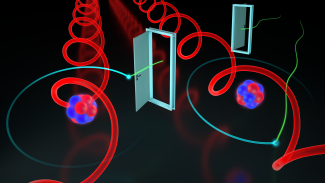The process of creating spin-polarized electrons has been studied for some time but continues to surprise physicists. These types of electrons have their spin aligned in a specific direction. The probability of creating a spin-polarized electron from an atom tends to be rather small except in some very specific situations. Yet, in a new paper published in Physical Review A, JILA graduate student Spencer Walker, former graduate student Joel Venzke, and former undergraduate student Lucas Kolanz in the Becker Lab theorized a new way towards enhancing this probability through the use of ultrashort laser pulses and an electron’s so-called doorway states. These doorway states are excited states of an electron in an atom that is closest to its lowest energy state, the ground state.
In their work, the Becker Lab did not directly study spin-polarized electrons but investigated an important step towards producing such electrons via these doorway states. Atoms have a set of electrons that rotate in one direction around the atom, while another set of electrons rotate in the opposite direction: the co-rotating and counter-rotating electrons. The Becker Lab used a circularly polarized laser pulse, in which the electric field rotates in space, to initiate ionization in these electrons, a process that causes them to leave the atom. And, they found that doorway states can specifically enhance the probability to ionize electrons, that rotate opposite to the rotation direction of the electric field of the laser
The ionization process is different for the counter-rotating electrons as compared with the co-rotating electrons. According to JILA fellow Andreas Becker: "The counter-rotating electrons can use excited states as a trampoline and can jump out with a higher probability. For certain wavelengths of the laser these doorway states can only be accessed by the counter-rotating electrons, but not by the co-rotating electrons. So, the trampoline can only be used by the counter-rotating electrons."
Jumping with Computer Codes
To study this further, the team used computer codes to determine what was happening. In describing the process, Spencer Walker explained: "We used two codes we wrote: a grid code and a basis code. For the basis code, we diagonalize the finite-difference Hamiltonian for argon and neon, the two atoms we studied, and then we write down the dipole interaction and wave function in energy basis for time propagation." In quantum mechanics, the Hamiltonian is an operator describing the interactions of the electrons in the atom and with the laser field, here being the counter- and the co-rotating electrons. From their work, the Becker Lab could show that since counter-rotating electrons are the only ones able to access the doorway states, their ionization probability can be 10 times greater than that of their co-rotating electron counterparts. This large difference was surprising to the whole team. "You come in with a theoretical prediction, so you have a picture in your mind." Becker said, "And all four of us working on this thought that this specificity of doorway states was a really cool effect, but we did not know that it could be so significant. This is one of the few times I've had in my career where you've had the idea before and the effect comes out so large. We were expecting maybe a factor or two, but now it's a factor of 10 or so."
Since the enhancement in ionizing a specific set of electrons---here those counter-rotating with respect to the laser field---is an important step towards generating spin-polarized electrons, both Walker and Becker believe that their proposed method would make this process more efficient. "In these laser pulses that we are studying theoretically, you create electrons in very short pulses,” Becker clarified. “These short pulses can allow you to do pump-probe experiments. And this may be opening an alternative pathway toward probing magnetic materials on ultrafast timescales." Becker and Walker both look forward to other physicists expanding on their work to produce spin-polarized electrons.
This work was supported primarily by the U.S. Department of Energy
Written by Kenna Castleberry, JILA Science Communicator



 The Physics Frontiers Centers (PFC) program supports university-based centers and institutes where the collective efforts of a larger group of individuals can enable transformational advances in the most promising research areas. The program is designed to foster major breakthroughs at the intellectual frontiers of physics by providing needed resources such as combinations of talents, skills, disciplines, and/or specialized infrastructure, not usually available to individual investigators or small groups, in an environment in which the collective efforts of the larger group can be shown to be seminal to promoting significant progress in the science and the education of students. PFCs also include creative, substantive activities aimed at enhancing education, broadening participation of traditionally underrepresented groups, and outreach to the scientific community and general public.
The Physics Frontiers Centers (PFC) program supports university-based centers and institutes where the collective efforts of a larger group of individuals can enable transformational advances in the most promising research areas. The program is designed to foster major breakthroughs at the intellectual frontiers of physics by providing needed resources such as combinations of talents, skills, disciplines, and/or specialized infrastructure, not usually available to individual investigators or small groups, in an environment in which the collective efforts of the larger group can be shown to be seminal to promoting significant progress in the science and the education of students. PFCs also include creative, substantive activities aimed at enhancing education, broadening participation of traditionally underrepresented groups, and outreach to the scientific community and general public.